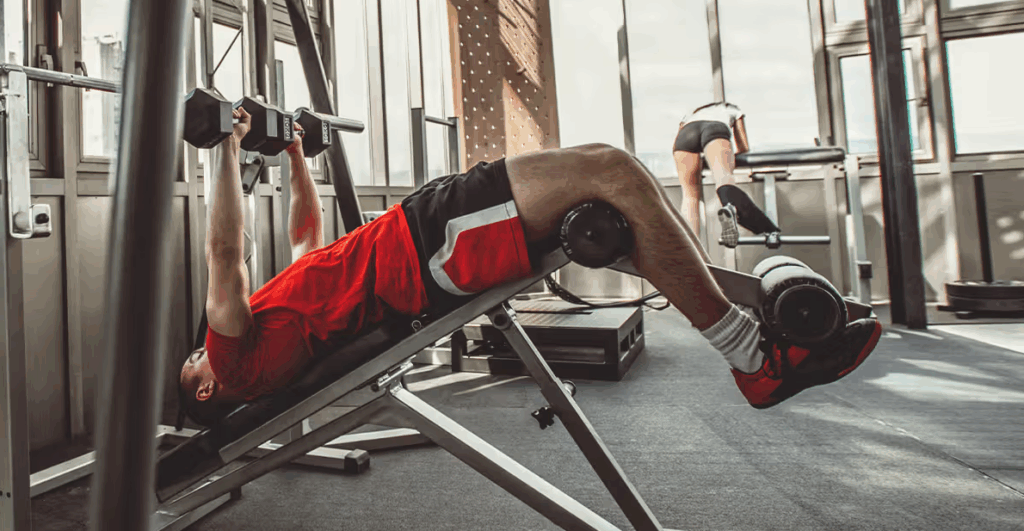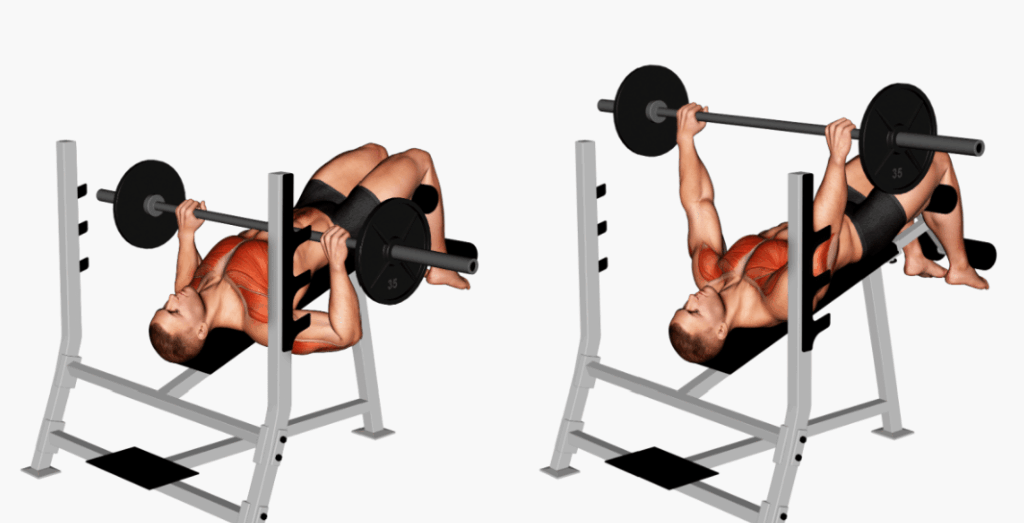To do the decline bench press safely, put your legs under the padded rollers and angle your bench 15 to 30 degrees. Hold the bar slightly wider than shoulder-width, lower it slowly toward your lower chest while keeping a slight arch in your back, and then press it up along a diagonal path.
Don’t bounce the weight off your chest, and keep your wrists straight and your elbows at a 45-degree angle to your torso. This method builds up your lower chest the most while keeping your shoulders safe from strain.
Benefits of the Decline Bench Press for Chest Development
While often overshadowed by its flat and incline counterparts, the decline bench press offers unique benefits for complete chest development. By positioning your body at a downward angle, this variation targets the lower pectoral muscles more effectively than standard bench press movements.
When performed with proper form, the decline bench press places less stress on your shoulders while maximizing activation of the sternal head of your chest muscles. It can be an excellent addition to your strength training routine, especially if you’re looking to build a more balanced, fully developed chest.
The decline position allows for potentially heavier lifting than incline variations, making it valuable for building raw pressing power and overall upper body strength.

Setting Up the Decline Bench Correctly for Safety
Before you try the decline bench press, make sure everything is set up correctly for your safety and the effectiveness of the exercise. First, change the angle of your bench to between 15 and 30 degrees. Make it steep enough to work the lower chest fibers, but not so steep that you could fall off.
To keep your body stable, make sure your legs are firmly under the padded rollers. When setting up your barbell grip, position your hands just beyond shoulder width, keeping your wrists aligned and wrapping your thumbs securely around the bar.
When lifting heavier weights, always make sure you have a spotter. Your spotter should be at your head, ready to help you get the bar to the rack or help you if you need it. Keep in mind that having the right equipment and having trained help nearby are both important for exercise safety.

Step-by-Step Technique Guide for Perfect Execution
Mastering the proper technique for the decline bench press guarantees both safety and excellent muscle development. Begin by securing yourself on the bench with your feet locked under the pads. Hold the barbell a little wider than shoulder-width, take it off the rack with straight arms, and lower it slowly toward your lower pectorals.
While keeping your shoulders pressed into the bench, keep your lower back slightly arched. As you perform this barbell bench press variation, breathe in during the descent and exhale forcefully when pressing upward. The bar should follow a slight diagonal path rather than moving straight up and down.
This controlled movement maximizes tension on your chest while minimizing shoulder strain. Among pressing variations, the decline requires particular attention to form for best results.

Common Mistakes and How to Avoid Them
Many lifters undermine their progress on the decline bench press by repeating avoidable errors. Using excessive weight is perhaps the most common mistake, forcing you to sacrifice form and reducing proper muscle activation throughout the movement.
Watch your bar path carefully. It should travel in a slight arc rather than straight up and down. It maintains ideal shoulder stability and prevents unnecessary strain. Maintain your elbows at about a 45-degree angle to your body instead of letting them flare wide, since that position helps reduce stress on the shoulders and lowers the risk of impingement.
Don’t rush to add this exercise to your workout routine without mastering proper technique first. Using momentum by bouncing the bar off your chest or relying on partial reps may let you move heavier weight in the short term, but it can stall real strength progress and raise your chances of injury.
Programming the Decline Press Into Your Chest Routine
When incorporating the decline bench press into your training program, you’ll need a strategic approach to maximize benefits while preventing overtraining. Consider using it as a secondary movement after the flat bench on chest day, performing 3-4 sets of 8-12 reps with proper fitness technique.
Experiment with grip width to target different parts of your lower chest. A wider grip emphasizes outer pecs, while a narrower grip engages more triceps. For beginners, start with once-weekly sessions; advanced lifters can include it twice weekly with varied rep ranges.
Pair decline presses with complementary exercises like incline work and flyes for balanced development. Allow 48-72 hours for chest recovery between sessions to prevent injury and support muscle growth.
Frequently Asked Questions
How Steep Should the Decline Angle Be for Maximum Lower Chest Activation?
Aim for a 15-30 degree decline angle for ideal lower chest activation. You’ll get the best results at around 20-25 degrees, as steeper angles shift focus to your shoulders and increase injury risk.
Can Decline Bench Press Help Improve My Bench Press Plateau?
Yes, it can help break your bench press plateau by strengthening underdeveloped lower chest muscles. You’ll build complementary strength patterns and overcome sticking points in your regular bench press movement.
Is Decline Bench Press Safe for People With Lower Back Issues?
Proceed with caution if you have lower back issues. Use a slight decline angle, guarantee your lower back is properly supported, and consider dumbbell alternatives. Always consult your healthcare provider first.
Should I Use a Wider or Narrower Grip Than the Regular Bench Press?
For the decline bench press, use a grip similar to your regular bench press width. If you have shoulder issues, you might benefit from a slightly wider grip to reduce stress on your shoulder joints.
Does the Decline Bench Press Put Less Stress on Shoulder Joints?
Yes, the decline bench press typically puts less stress on your shoulder joints compared to the flat bench because the angle reduces shoulder extension and places more emphasis on your lower chest muscles.








